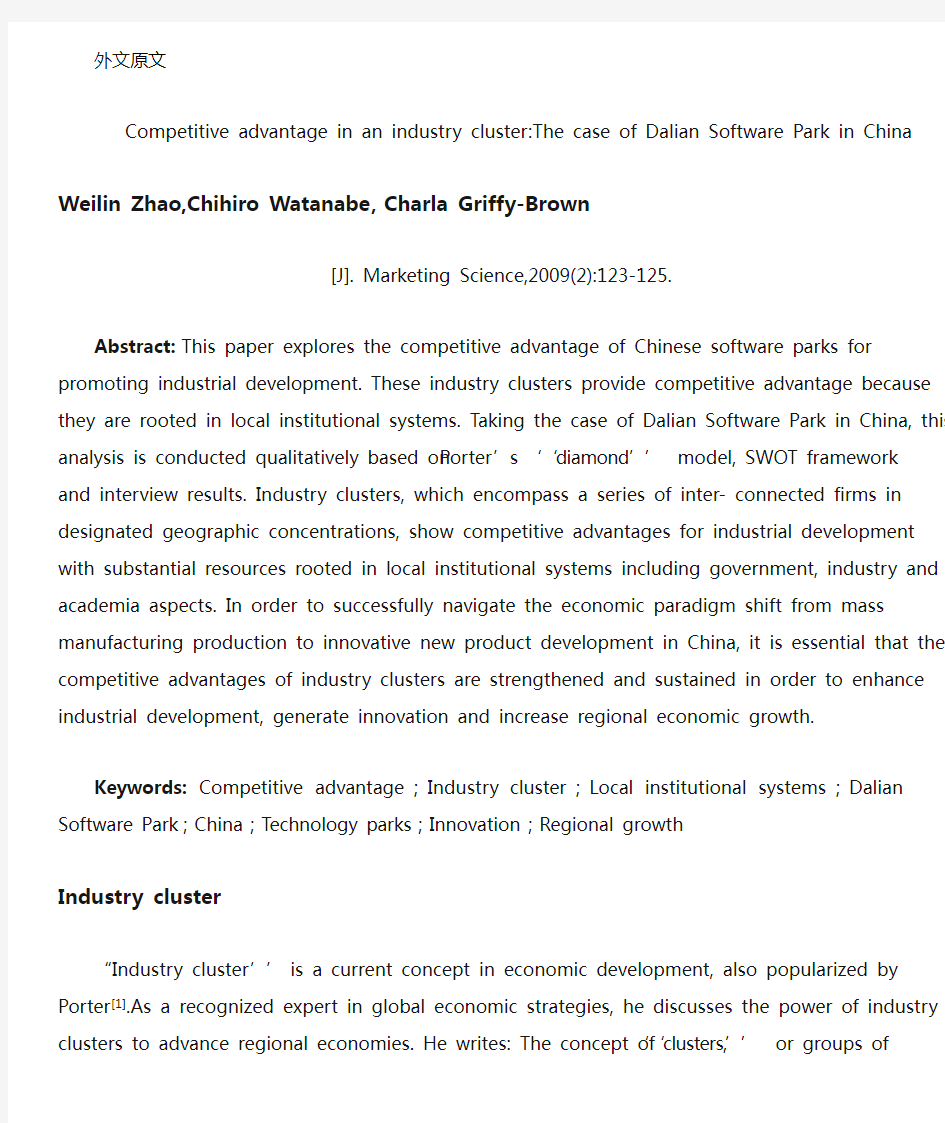外文翻译--产业集群的竞争优势——以中国大连软件工业园为例

- 1、下载文档前请自行甄别文档内容的完整性,平台不提供额外的编辑、内容补充、找答案等附加服务。
- 2、"仅部分预览"的文档,不可在线预览部分如存在完整性等问题,可反馈申请退款(可完整预览的文档不适用该条件!)。
- 3、如文档侵犯您的权益,请联系客服反馈,我们会尽快为您处理(人工客服工作时间:9:00-18:30)。
外文原文
Competitive advantage in an industry cluster:The case of Dalian
Software Park in China
Weilin Zhao,Chihiro Watanabe,Charla Griffy-Brown
[J]. Marketing Science,2009(2):123-125.
Abstract:This paper explores the competitive advantage of Chinese software parks for promoting industrial development. These industry clusters provide competitive advantage because they are rooted in local institutional systems. Taking the case of Dalian Software Park in China, this analysis is conducted qualitatively based on Porter’s‘‘diamond’’ model, SWOT framework and interview results. Industry clusters, which encompass a series of inter- connected firms in designated geographic concentrations, show competitive advantages for industrial development with substantial resources rooted in local institutional systems including government, industry and academia aspects. In order to successfully navigate the economic paradigm shift from mass manufacturing production to innovative new product development in China, it is essential that the competitive advantages of industry clusters are strengthened and sustained in order to enhance industrial development, generate innovation and increase regional economic growth.
Keywords: Competitive advantage;Industry cluster;Local institutional systems;Dalian Software Park;China;Technology parks;Innovation;Regional growth
Industry cluster
“Industry cluster’’ is a current concept in economic development, also popularized by Porter[1].As a recognized expert in global economic strategies, he discusses the power of industry clusters to advance regional economies. He writes: The concept of ‘‘clusters,’’ or groups of interconnected firms, suppliers, related industries, and institutions that arise in particular locations, has become a new way for companies and governments to think about economies, assess the competitive advantage of locations, and set public policy. However, there has been no exact definition of ‘‘industry cluster’’ until now. Recent research by
Doeringer and Terkla[2]and Leveen[3]examine the literature regarding industry clusters and identify them as‘‘geographical concentrations of industries that gain performance advantages through co-location’’.‘‘Geographical concentration’’is the key that defines the basic but distinctive characteristic of an industry cluster.As a specialized concentration of firms and industries in a region, they usually have common markets, and share common suppliers, trade, or education institutes, and intangible things like know-how and information; similarly, they also may face similar opportunities and threats. There are many industry cluster development models in countries around the world. For example, in the U.S., Silicon Valley (California) and Route 128(Massachusetts)are well-known industry clusters. The former is famous for microelectronics, biotechnology, and venture capital markets while the latter is well known for its software, computer, and communications hardware [4].
The reasons why software firms tend to cluster were analyzed, with a special focus on the transfer of infor-mation and knowledge [5]. In fact, although research about industry clusters has been examined from the perspectives of economic development, strategic management, knowledge sharing, and technology spillover, there is little research that addresses the competitive advantage offered by industry clusters that are based on institutional systems.
As introduced by Leveen[6],industry clusters can be classified into two types :vertically integrated clusters and horizontally integrated clusters. The first type of cluster is ‘‘made up of industries that are linked through buyer-seller relationships’’; the second one ‘‘includes industries which might share a common market for the end products, use a common technology or labor force skills, or require similar natural resources’’ [6].The software parks that we examine in this paper can be considered part of the second type.
